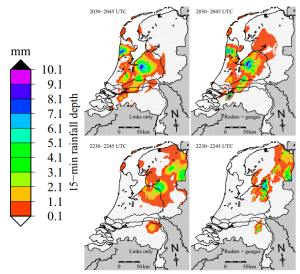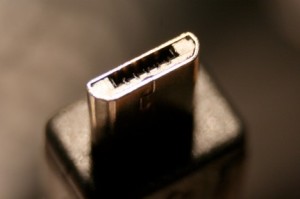Mobile masts measure rainfall

Space-time dynamics of 15 min rainfall depths (two panels per time step) from links (left) and radar s plus gauges (right) for September 10, 2011, 2030–2045 and 2230–2245 hours UTC.
Traditionally rainfall has been measure by low tech rain gauges that simply measure the height of rainfall in a certain area. But these need to be manually placed across a large area and individually read. Because of these requirements, the number of in-place rain guages has been rapidly falling in recent years. Other methods include using radar absorption but mobile phone signal has the significant advantage in that it’s much more widespread across most countries.
Using mobile phone radio waves was first tried out in 2006. Scientists from the University of Tel Aviv published in renowned journal Science claiming that their technique proved to be more accurate that measurements used by normal weather services. They found that rain is particularly good at weakening the strength of electromagnetic waves meaning it’s perfect for being measured by mobile signal strength. Usually mobile phone masts already use this information to automatically boost signal strength when they notice rainfall or other causes has produced a drop in coverage.
The Netherlands was a perfect country to test in as although it is quite small at approximately 35,000 square kilometres, it has about 2,400 mobile phone masts linked together to provide valuable data. The test were conducted on T-Mobile’s masts over two 12 day periods and the scientists were able to generate real-time rainfall data from their readings. The novel method has proved its value and may well turn out to be even more useful in countries with a good mobile phone network but more meteorological infrastructure.
 O2 has made a plea for mobile retailers to cut down on waste by not automatically bundling chargers when selling new handsets. Since all the mobile manufacturers in the world agreed that all mobile phones should use a common micro-USB charger, more and more people are able to forgo a new charger as they already own a compatible one. O2‘s request comes after a three month long pilot on the HTC One X+ handset which has been sold through O2 stores with only a USB cable included.
O2 has made a plea for mobile retailers to cut down on waste by not automatically bundling chargers when selling new handsets. Since all the mobile manufacturers in the world agreed that all mobile phones should use a common micro-USB charger, more and more people are able to forgo a new charger as they already own a compatible one. O2‘s request comes after a three month long pilot on the HTC One X+ handset which has been sold through O2 stores with only a USB cable included. In a recent interview with CBS, Bill Gates has admitted that Microsoft missed a trick with the popularity of smartphones. Gates, ex-CEO of Microsoft and the founder and funder of the largest transparently operated private foundation in the world was probably referring to quotes made around the time the iPhone originally launched.
In a recent interview with CBS, Bill Gates has admitted that Microsoft missed a trick with the popularity of smartphones. Gates, ex-CEO of Microsoft and the founder and funder of the largest transparently operated private foundation in the world was probably referring to quotes made around the time the iPhone originally launched.


Recent Comments